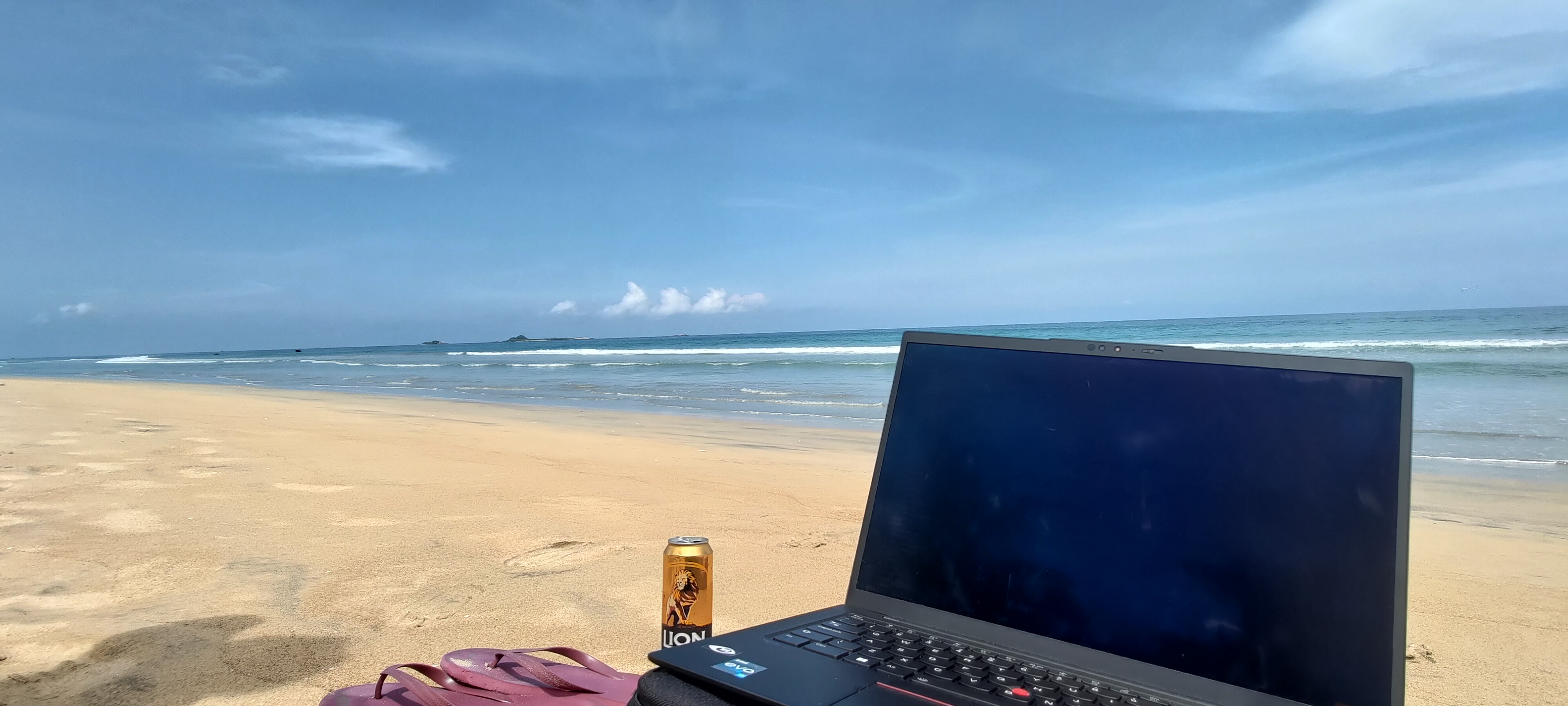thinkpads galore and my shift to Linux computing
I’ve recently bought myself my second Thinkpad. I’ve been daily driving a Lenovo Thinkpad X1 Carbon Gen 10 with Linux for almost 2 years now. It has served me very well and in this blog post, I discuss how this family of machines has fit into my productive working schedule, and any project work that I have been doing alongside this.
1. My first Thinkpad, and why I’ve decided to use this machine
Around the same time I bought my first personal productivity/learning-focused Thinkpad X1 Carbon Gen 10, I was using a Macbook Pro M2 for work. What I really liked about my Macbook was the battery life, the ease of use of MacOS, the build quality, and the all-aluminium chassis. When I was issued that as a company device, I admired the simplicity of that machine, and how everything ‘just worked’. In hindsight, I admit a large portion of that is down to the OS that on the machine and less do with the hardware. All this doesn’t mean that the laptop is perfect by any stretch.
Because of my shoes or clothing, I often found myself being statically shocked while I was in the office and I touched the aluminium chassis of the laptop. I found that to be very annoying, but not a deal breaker. In my current role - we are issued laptops with an all-aluminium body and I often find myself shocking myself on the chassis after long walks in the office. Another thing was that the RAM that was issued to all staff members for these Macs were woefully inadequate. It was only 8 GB. This seemed to be okay for most users in that business, but later in that role I got interested in development and the RAM amount just wasn’t okay. My web browser is also full of open tabs, and found that my machine slowed down when I had my web browser open, I also found running most virtual machines outside lightweight Linux distrutions a hard task.
So to develop my own tools, projects and general productivity - I found myself in the market for a new machine at the time. I had a think about some of the things I really enjoyed about my work’s Mac M2, and the things I want to achieve with a new project machine:
- I wanted to get decent at using and administering Linux machines, for the purposes of taking the CompTIA Linux+ exam.
- I wanted a machine to be thin and light, and portable enough to fit into a bag with plenty of space to spare.
- The hardware needs to be strong enough to easily last me a few years. I need to be able to run, at a maximum, a Windows virtual machine with 16 GB of dedicated RAM.
- The build quality needs to be solid, but not nescessarily an all metal/aluminium chassis.
So I bit the bullet and purchased a used Lenovo Thinkpad Gen 10. At the time, I felt that it was the perfect machine for my needs, and once I slapped Linux Mint on it, the puzzle pieces started coming together. However, this would be the first time that I’ve dedicated a whole machine to Linux, and the first time that I would be daily driving Linux in general. In the past, I’ve used Linux in virtual machines for educational purposes only.
As most Linux users experience, I immediately ran into problems. Things that seemingly worked perfectly fine in Windows simply did not work in Linux, such as the webcam module and the fingerprint reader. Luckily for me, I never use these functions on my device, nor do I intend to in the future. Fixing these have remained on my personal ‘To do’ list. But these have been at the bottom of my list since, up until this day. I did experience some other problems such as the SIM card slot not working, but these were fixed through some tweaking and searching of Offical drivers. Prior to purchasing the device, I did read that Thinkpads are very Linux-friendly, but I suppose my choice of distribution, coupled with the fact that the drivers for the parts I mention were not packaged as part of the standard build for the OS, are the reasons they don’t work.
I only have experienced two main hardware-related issues.
- The battery and power-hungry processor:
-
The battery for a device this age is quite simply, pitiful. I often find myself having to recharge this device. My train into work from Cambridgeshire to London is only around 1 hour 5 minutes and this journey often brings this device from a full charge to below 40%. Coming from a Macbook Pro M2, this was a huge stuggle to deal with at the start. I have investigated and I know what the cause is.
-
This device comes equipped with the notoriously-power hungry 12th Gen Intel i7-1260P processor. It has 12 cores and 16 threads, and it runs at 4.7 GHz. It is great for the tasks I throw at it and the several virtual machines I can now run parallel to each other, but the power consumption is high.
-
I’ve used the upower module in my system, and run
upower -i $(upower -e | grep -i BAT). My device is currently on 221 charge cycles. This is a lot for a laptop and this is also a factor. This module tells me that this device’s battery can hold around 41.97 Wh of energy when full, which is sigificantly less than the designed 57 Wh from new. I am happy to replace the battery once it start to become a serious issue, however I always carry a decent charger with me at all times and it hasn’t become enough of an issue to address.
-
- The trackpad size:
- The size of the trackpad is not ideal, it is slightly too small. This issue isn’t nearly bad as the others I’ve mentioned - and I have gotten used to it over time. The palm and touch rejection is not perfect but this also manageable and I have gotten used to it over time.
In retrospect, both these issues could be down to the fact that I have come from a very compentent and well-built Macbook. It is worth remebering, with all these issues - I still managed to secure this machine for less than half the price of a similarly-specced, used Macbook Pro M1 at the time.
But that being said, I love this laptop!
Apart from the issues, in general I love this device. It has been a trusty sidekick when travelling, easily handling my projects and coding projects. It’s also been abroad several times, in places such as Gibraltar, Spain and Sri Lanka. Travelling throughout the UK for work and various other endevours, means that I can carry this laptop with ease. I made sure to get a model that has 32 GB of RAM so I can run my virtual machines with little issues. Sometimes I am able to run multiple VM in parallel to get work done and this is great.


Right: The view I was treated to at the time. Taken in Trincomalee, Sri Lanka.
Being a Thinkpad, the keyboard is very nice to type on. I have really enjoyed coding on this device. I have been looking on forums online and I can see that others prefer the older keyboards with greater key travel and more solid feel. I am a user of a custom-built mechanical keyboard for my gaming machine at home and I feel right at home here. The force you need to apply each key to actuate it, is just right. The build quality of this device is good, and I have no concerns about this device holding up to the test of time. It is elegant enough to not feel out of place in formal settings and not garish or flashy enough to stand out in the crowd. I made the right choice in my eyes.
2. My recent addition
After my overall success of adding the X1 Carbon to my toolkit of devices I can rely on, I have decided that I need a Windows-only laptop for calls and online cerification exams. I am doing a lot of my recent certification through Pearson VUE, and after selling an old laptop I had been using for this purpose on Ebay, I needed something to replace it. Pearson VUE online exams uses a very intrusive piece of software for the exams themselves and of course - it is incompatible with Linux natively.
The specs are: Intel i5-8350U, Integrated Graphics, 256GB Samsung NVme SSD, 32GB DDR4 3200 RAM. This device should be fine and fit for the purpose I intend to use it for. Upon getting it on my hands for the first time, I can feel that the device is much thicker and heavier than my X1 Carbon. This makes sense, given that the X1 Carbon is the ‘Thin and Light’ range of Thinkpads.
The keyboard feels solid and you need much more force to actuate a key when you compare it to the X1 Carbon. I feel like I can drop this from a decent height without it breaking. I can’t really say the same for my coding machine - but they are being used for different purposes.
There’s a big community online who really love this particular machine. A lot of the Thinkpad enthusiasts commonly say that the T480 is the ‘last real Thinkpad’ I’m not sure if I can fully agree with that but it does have some of the creature comforts of modern devices, such as two type-c charging ports for charging. It has some ‘nice to haves’ such as a full-sized ethernet port for metwork troubleshooting.
I’ve even tried to play some games on it. I’ve played League of Legends on it, and it seems to run fine. The hardware seems to be enough for a laptop in 2025. Things like the inbuilt fingerint reader works in Windows out of the box. I haven’t tried any other OS on this laptop, other than Windows.
This laptop has practicality built in. It has two batteries, one externally built-in and one internal. You can get a high-capacity version of the external battery. It’s worth noting at this point that Lenovo and Thinkpads more generally are just more repairable than other brands. It is trivially easy to order offical replacement parts for Lenovo Thinkpads, and the 3rd party market is vast.
The only thing I could seriously fault the T480 for, is it’s bezel size around the display. It is too large for my liking, especially towards the bottom of the display towards the hinge. On a less serious note - the T480 is bulky, so you should be ready for that if you plan on travelling with the T480. Generally speaking, the weight and size of the device is manageable for me though.
3. Conclusions
For the price, this laptop is a bargain - and a great way to spec a machine (laptop) for a family member who just needs access to the internet. It is highly repairable and a good bet for something that just works. I’d reccommend the T480 for almost everyone.
Enjoy Reading This Article?
Here are some more articles you might like to read next: